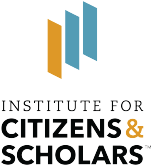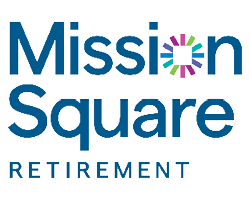By Sara McPhee-Knowles
Introduction:
Over the last 20 years, citizens’ assemblies have become more prevalent. Governments are dealing with more complex policy problems, along with increasing polarization. Citizens’ assemblies can be an innovative means to engage the public in a more meaningful way, if they are used to answer the right questions and implemented properly.
What makes a citizens’ assembly different from other kinds of public engagement exercises? The Federation for Innovation in Democracy – North America (FIDE) released a document in October 2024 called “Putting the Public Back in Public Policy – Citizens’ Assemblies: An Introduction to Definitions and Guidelines,” which outlines seven principles that differentiate citizens’ assemblies from other public engagements, including those that have deliberative elements.
The first citizens’ assembly in the Yukon Territory took place in 2024. This assembly was convened to examine electoral systems and recommend whether the current electoral system used to elect members of the Yukon Legislative Assembly (MLAs) should be retained, or a new model should be adopted. The recommendation to form a citizens’ assembly came from a Special Committee of the Yukon Legislative Assembly on electoral reform (SCER), which ran from 2021-2023 and conducted a lot of public engagement that didn’t lead to a clear answer; the citizens’ assembly was formed to get a recommendation from citizens.
A second special committee was formed to develop the terms of reference and timeline for the citizens’ assembly. I was appointed Chair of the Yukon Citizens’ Assembly on Electoral Reform (YCAER) from February-November 2024 and was primarily responsible for implementing the citizens’ assembly, along with a small team of staff.
This article will describe each of the seven principles from “Putting the Public Back in Public Policy” and explain how the YCAER implemented those principles.
Principles:
The seven principles outlined in “Putting the Public Back in Public Policy” are representativeness, a clear remit, adequate time, diverse information, deliberation, a free response and a final report, and accountability. The following section will explain how the YCAER incorporated these principles.
(1) Representativeness
The principle of representativeness refers to ensuring that participants in the room look demographically like the area they are representing. To accomplish this, selection is often done through a democratic lottery or sortition method. Even with a perfect sortition process, not everyone who is invited to participate will accept the invitation; barriers to participation must be addressed so that those who are selected are able to participate.
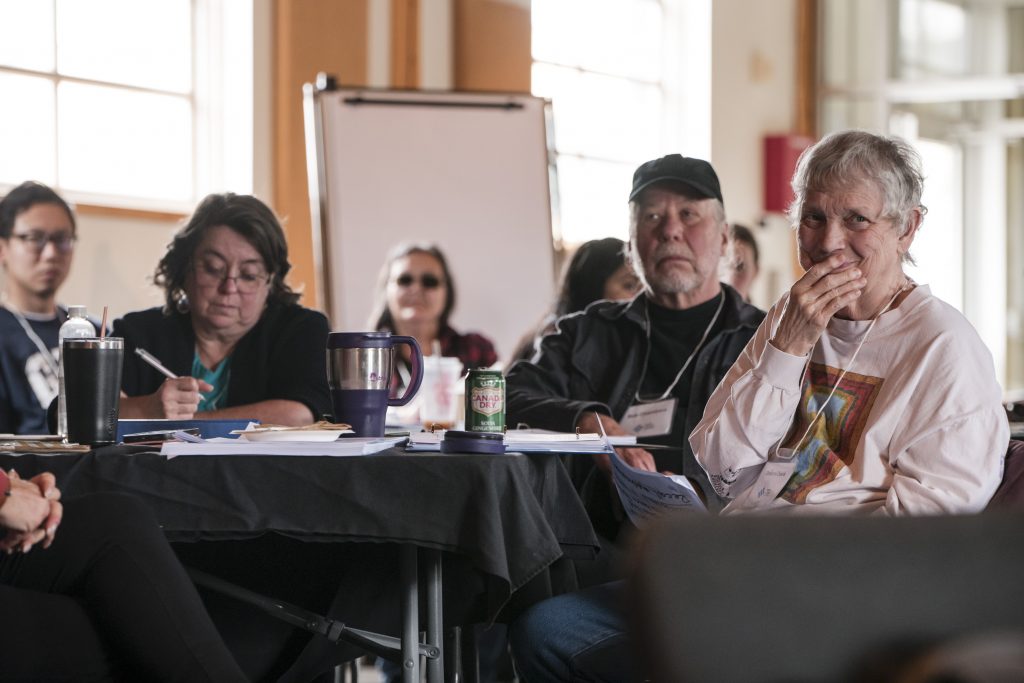
Photo courtesy of Erik Pinkerton Photography.
The selection process in the terms of reference for the YCAER was not a typical democratic lottery. As part of the SCER public engagement process, a second survey was conducted in early 2023 that asked respondents for input on the structure of the YCAER and if they would be willing to participate in a citizens’ assembly. Approximately 1,800 of the 6,000 Yukoners who completed the survey said they would volunteer for a citizens’ assembly, and participants were selected from this pool. Geographic representation in the assembly was addressed by the requirement to have two members from each of the 19 electoral districts for a total of 38 citizens’ assembly members. The Yukon Bureau of Statistics completed the selection from the pool, using existing data on age, gender and Indigenous ancestry.
Following selection, the deputy chair and I called everyone who had been selected and confirmed those who were able to participate. Not everyone who had been selected was able to participate, which led to a final citizens’ assembly that did not exactly match the Yukon population: the assembly had 42 percent women and 58 percent men and skewed older. The YCAER members also were much more likely to vote than members of the general population, which makes sense given that they were interested in the issue of electoral reform enough to complete a public engagement survey on the subject.
To remove barriers to participation, we paid participants an honorarium of $200 per day (the highest amount in the regulation specifying board honoraria) and travel costs for members traveling from outside of Whitehorse. We also offered members who were caregivers for elders or children under the age of 16 an additional $100 per day to help cover alternative care arrangements, without needing to provide a receipt. There are few options for weekend care at licensed daycares in Whitehorse, so this option allowed participants to compensate informal caregivers. As a staff team, we also did whatever we could to accommodate dietary restrictions or other needs of members so that they could participate fully, which included things like booking pet-friendly hotel rooms on request and booking a bus for the meeting that was held in Carcross, a small community 72 km outside of Whitehorse.
(2) A Clear Remit
A clear remit refers to a “well-defined scope that empowers participants to address specific problems and explore potential solutions within agreed upon parameters.” The mandate for the YCAER was set by a second special committee of the Yukon Legislative Assembly, the Special Committee on the Yukon Citizens’ Assembly (SCYCA), which specified the mandate as “the YCA shall examine electoral systems and issue a report recommending whether the current model used for electing Members of the Yukon Legislative Assembly should be retained or another model should be adopted.”
The terms of reference also spelled out some criteria for making a recommendation: encouraging consensus in decision-making, reflecting the balance of urban and rural representation in the recommendation, ensuring any recommendation be consistent with the Canadian constitution and parliamentary system, and, if recommending a different model for electing MLAs, only recommending one model and describing it in detail in the report. These additional criteria defined some parameters more clearly but left space for YCAER members to do the learning and deliberation required to collectively draft proposals that answered the policy question of which electoral system should be used in the territory.
On the last day of the YCAER, an MLA who came to hear the recommendations presented by YCAER members apologized for the narrow scope of the mandate to the YCAER; a YCAER member commented that it was a good thing that the mandate was narrow because the citizens’ assembly didn’t have time to go beyond the scope that was given.
(3) Adequate Time
The recommended minimum amount of time for a citizens’ assembly is 36 hours, or four in-person days. Citizens’ assemblies are lengthy processes because participants require time to learn about a complex issue, build their ability to work together and consider tradeoffs, and carefully deliberate to come to rough consensus on recommendations. The YCAER met for eight in person days over four weekends between May and September 2024. The learning phase took place over the first two weekends, which were two weeks apart at the end of May and beginning of June. The deliberation phase took place over two more weekends, also two weeks apart at the end of August and beginning of September.
This schedule accounted for local seasonal realities and the prescribed deadline for tabling the final report by October 31, 2024. The Yukon has short summers, and many people have camping or travel plans (especially during the school break for K-12 students). Hunting season begins in August but picks up later in September and early October. As an organizing team, we offered three optional sessions over Zoom during the summer break to provide additional information and to address information gaps the citizens’ assembly members identified. These sessions were recorded, and recordings and transcripts were made available to members.
In addition to the learning and deliberation phases, many assemblies have a public input or listening phase. In our case, because the SCER had conducted extensive public engagement and the timeline was tight, we opted for a smaller listening phase that included one public information session held in Whitehorse (which was recorded and posted online) and a public submission process from May 25-August 12, 2024. The submissions were provided to the members, and a summary was presented at the August meeting.
One element related to adequate time that’s relevant for organizers, but not explicitly noted by FIDE, is lead time. Given the tight timeline required by the terms of reference and the seasonal elements already mentioned, there was not a lot of time between the start of my appointment on February 2nd and the first meeting on May 24th and 25th to do all of the set up including finding staff, selecting members, booking all accommodations and meeting locations, and planning overall curriculum and speakers for the first two sessions. More time leading into the first session would have benefited the set up stage.
(4) Diverse Information
Diverse information refers to assembly members “exploring a wide range of sourced and diverse perspectives, including expert opinions requested by participants” to support deliberation and the resulting recommendations. The information provided to the assembly members should be balanced and trustworthy.
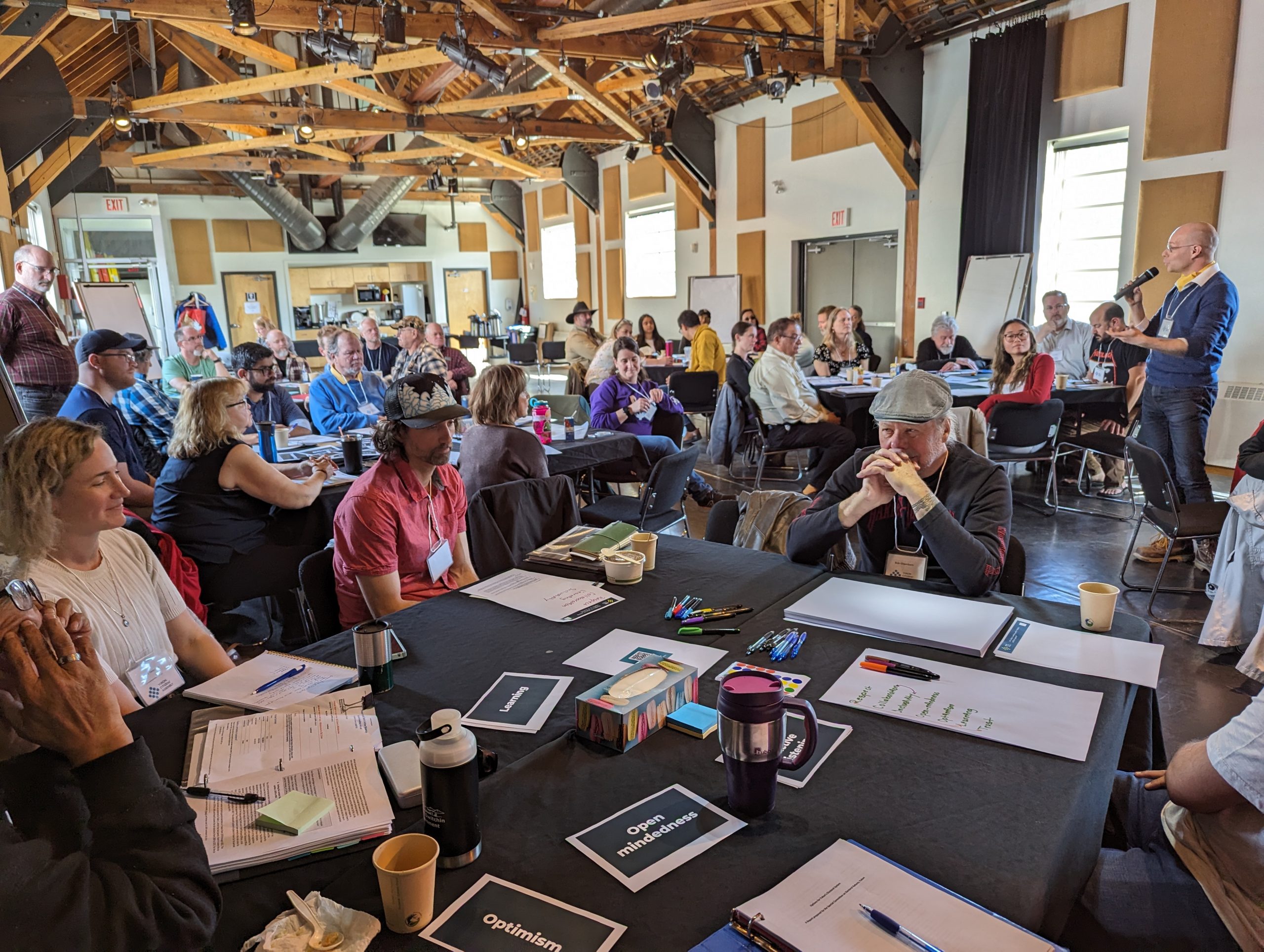
Photo courtesy of Michael Vernon.
As the chair, I developed the overall plan for the assembly’s work, including selecting speakers for the learning phase, and the plan was reviewed by our arms-length Advisory and Oversight Group. At the end of the learning phase, I asked participants what additional information they felt like they needed to inform their recommendations. One request was for additional information on consensus governments, so one of the optional sessions that we held was with an expert on consensus government in the Northwest Territories and Nunavut. A number of participants also requested that Jonathan Rose, who presented different electoral systems during the second session, be brought back for the August session, and we hosted an optional Zoom Q&A session with him about a month after the second meeting. In this case, I felt it was important for participants to highlight where they felt there were gaps in their knowledge, rather than requesting specific experts.
(5) Deliberation
This principle highlights the importance of skilled, independent facilitation to foster open, respectful dialogue, where participants listen to different perspectives and ideas that reflect a diversity of voices and consider these carefully as they work toward building recommendations. Participants moving from learning about the subject at hand to considering options and weighing trade-offs as they develop rough consensus on recommendations is truly the magic of citizens’ assemblies.
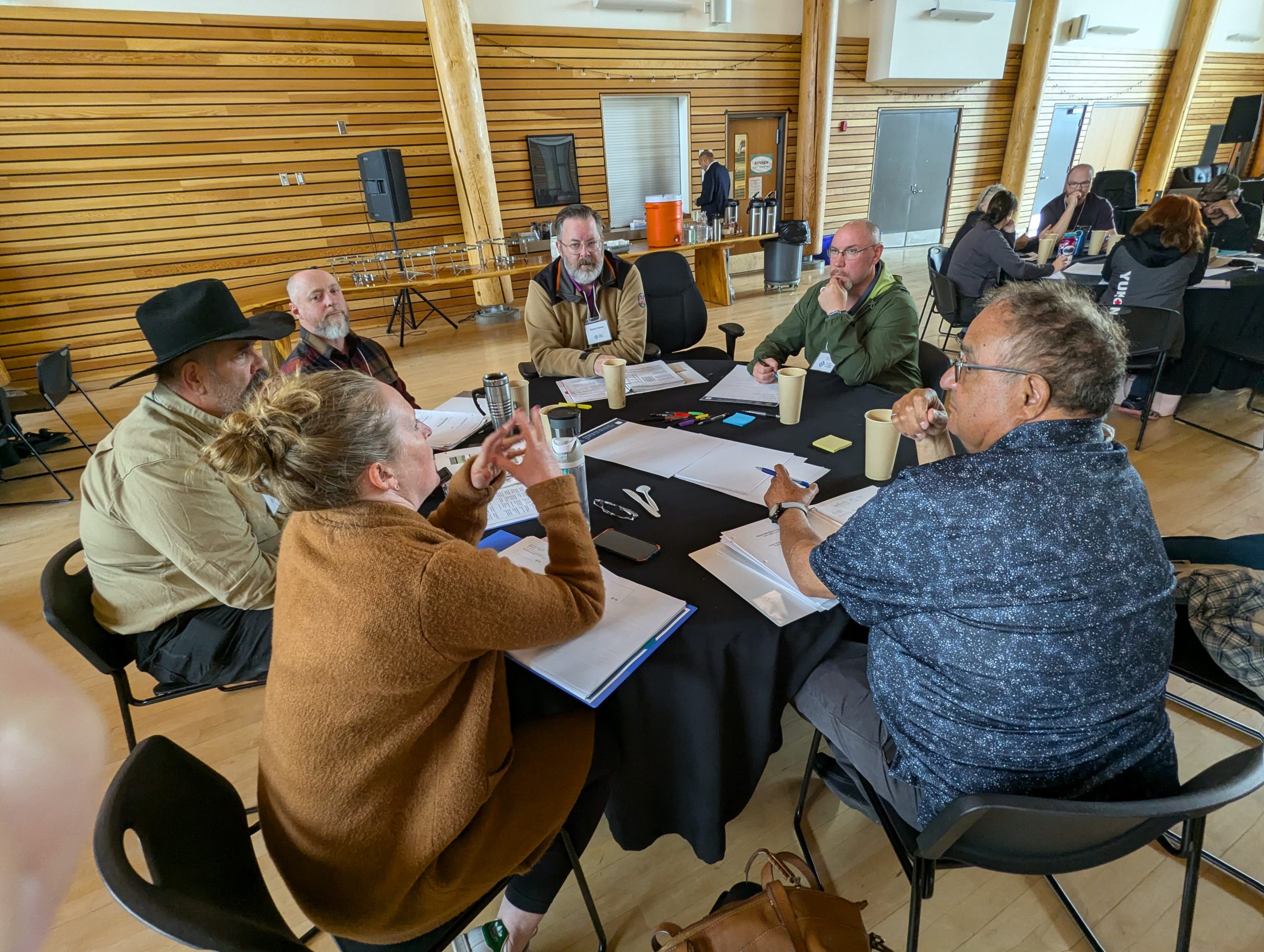
Photo courtesy of Michael Vernon.
To support deliberation, I hired Yukon University undergraduate students as facilitators. They completed a weekend training course with Mass LBP in early May, where they learned about citizens’ assemblies and specific facilitation techniques. We used a very low-tech facilitation approach for small group discussions; there was one student facilitator per table, and they would ask probing questions and summarize the group’s points by hand in marker on 11×17 sheets of paper. These main points were reported out verbally to the larger group by one YCAER member per table and aggregated at the front of the room by the deputy chair or comms analyst while I moderated the larger group discussion as chair. Report outs were often audio recorded for creating more fulsome summaries, but these recordings were not shared.
To foster active listening and respectful exchange, during the first meeting we spent quite a bit of time adapting procedures for the work of the citizens’ assembly and developing two sets of shared values: one for working together and the other for values underlying an electoral system in the Yukon. Both were referred to during the subsequent meetings; in particular the electoral system values became a compass guiding the members’ decision-making throughout the deliberative phase. This groundwork built an environment that enabled respectful disagreement, an essential ingredient in the deliberation process.
(6) A Free Response and a Final Report
This principle requires that participants develop their own recommendations and rationale based on the learning and deliberation they undertook as a group. An open-ended and independent approach is more likely to result in creative solutions to problems, and participants conveying their recommendations in their own words ensures that the end result is an accurate reflection of the learning and deliberation that took place. During the citizens’ assembly process, participants draft their recommendations in their own words and present them to the commissioning body.
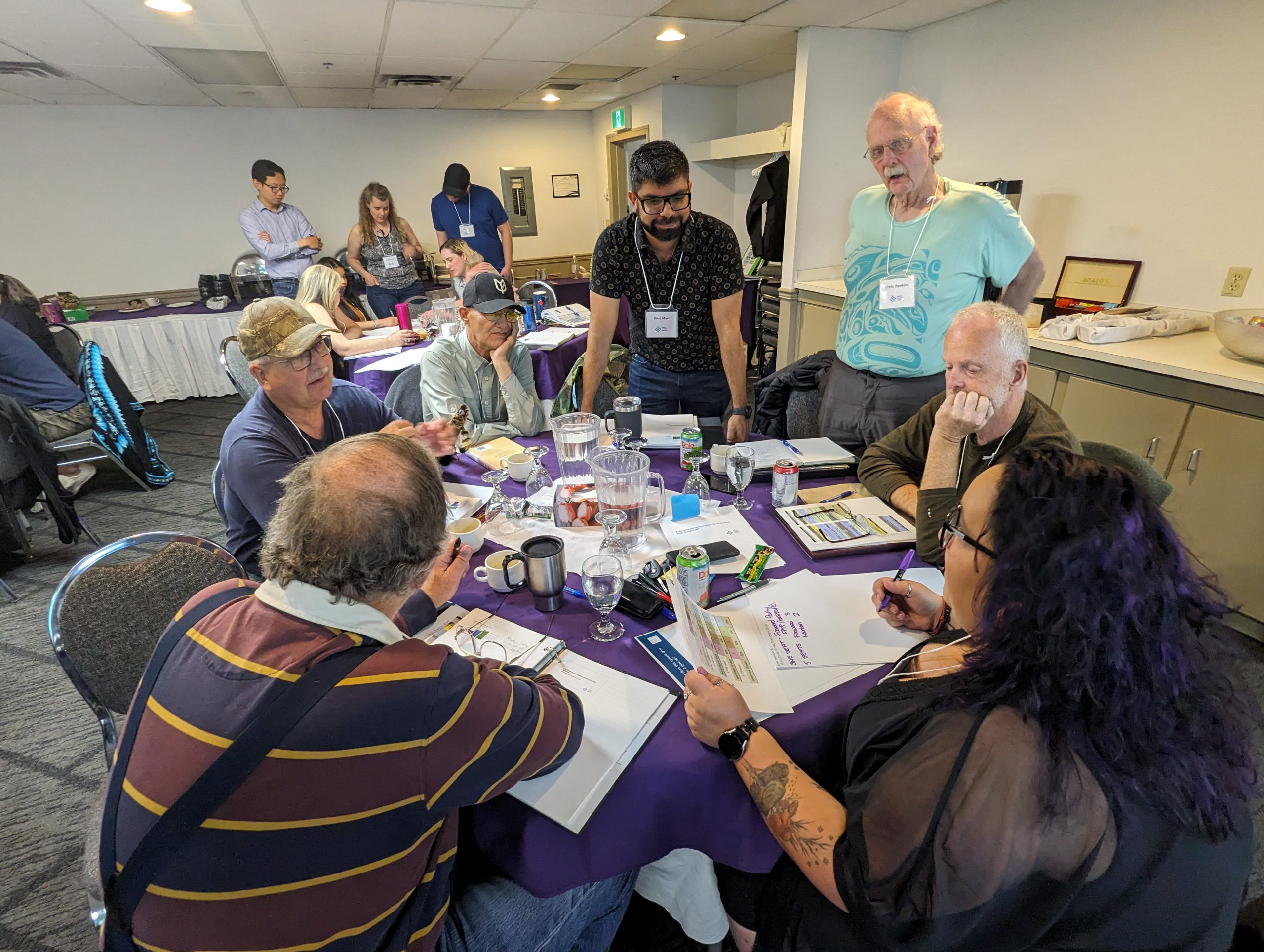
Photo courtesy of Michael Vernon.
In the YCAER final report, the section “The report from the Yukon Citizens’ Assembly Members” was collectively drafted after the recommendations had been voted on. Drafting took place in the final Saturday afternoon and Sunday morning. Each section was assigned to a table, and participants were free to move around and choose which subsection they would prefer to work on. In addition, one self-selected group led drafting the minority report. The table groups drafted their sections and reported them out verbally twice, allowing for two rounds of feedback. We also added some additional sections (for example, the preamble) based on what the overall group felt was missing after hearing all the sections. Some participants had brought laptops with them, and the final drafting push was the only time when I wished we’d had a laptop at each table instead of relying on hand-written notes, as the groups that had a laptop had an easier time incorporating suggestions. A subgroup of about 12 members volunteered to review and edit the overall report in depth before it was circulated to all participants for review before design and printing.
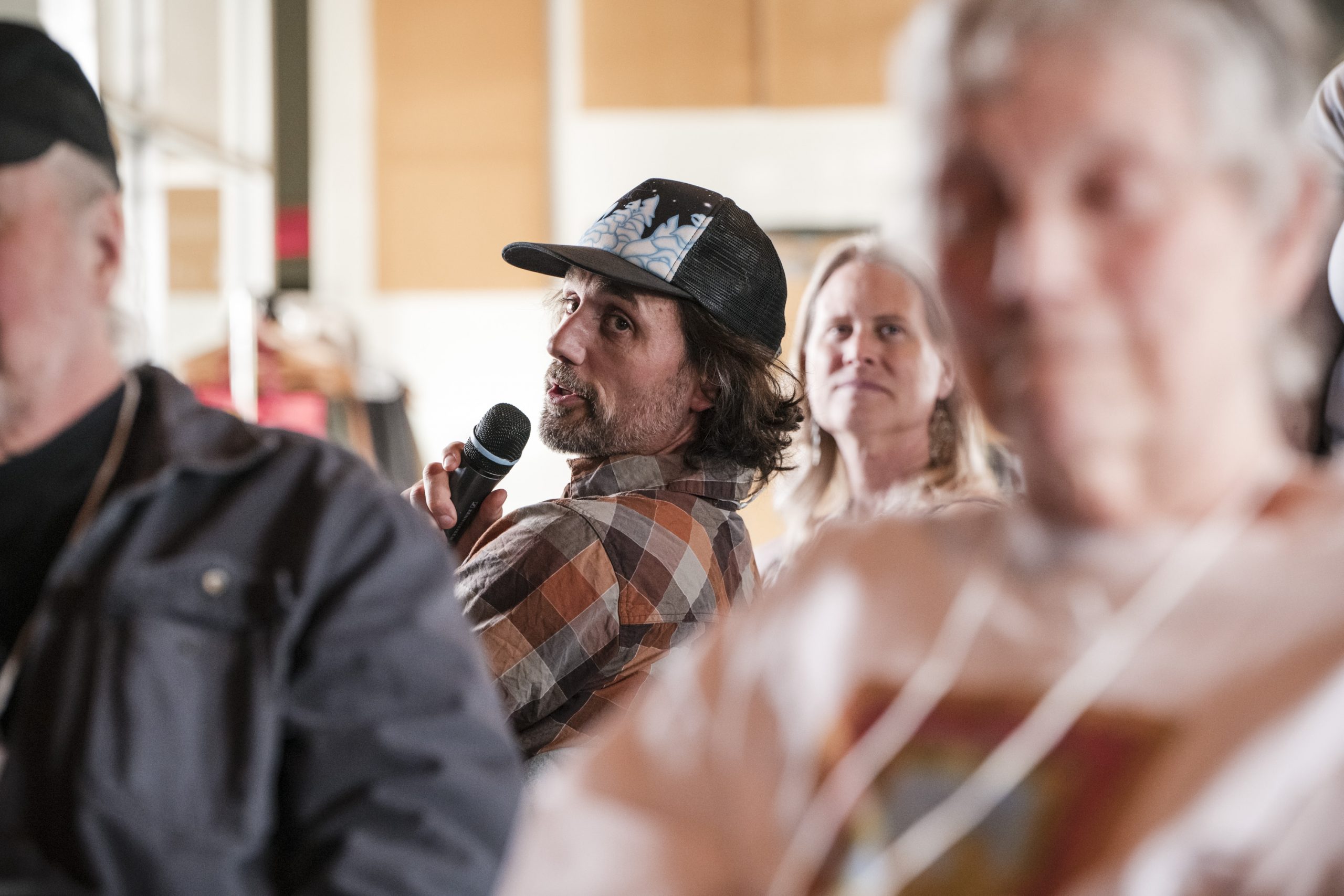
Photo courtesy of Erik Pinkerton Photography.
On the final Sunday afternoon, two MLAs attended a presentation of the YCAER’s recommendations. The presentation covered how the citizens’ assembly worked, what the members learned, their values, their recommendation of a ranked vote system and their rationale. Seeing a representative from each table stand up to present a section and feeling the support of the room was powerful. There was a conversation with questions back and forth between the YCAER members and the two MLAs after the presentation. This presentation formed the basis of the Statement by Assembly Members that was posted online a few days after the final meeting, before the report was made public.
(7) Accountability
This principle requires clear communication from the commissioning body about how recommendations from the citizens’ assembly will be responded to in a timely fashion.
Following the presentation made to MLAs on the final meeting day, the Yukon Liberal Party caucus announced their interest in putting the recommendation from the Citizens’ Assembly to the public in a plebiscite, which would be held at the same time at the next territorial election in 2025.
Conclusion:
This article has summarized the seven principles outlined in “Putting the Public Back in Public Policy – Citizens’ Assemblies: An Introduction to Definitions and Guidelines,” and outlined the way that these principles were incorporated in the design and execution of the YCAER. Why is it important that these principles be used in citizens’ assemblies? Citizens’ assemblies are not an appropriate means of addressing every policy problem – they are expensive and time-consuming to implement well, and are best suited to issues that are complex, polarizing, underscored by values and lack a clear ‘correct’ answer. When citizens’ assemblies incorporate the principles outlined here, the participants will reflect the composition of the population, have enough time to develop a strong understanding of the issues at play and consider different perspectives and trade-offs as they deliberate to reach recommendations.
Sara McPhee-Knowles is an assistant professor at the Yukon University School of Business and Leadership.
